As stated, a breed can be described as a group of animals having a common origin, which, through selection and breeding have distinctive characteristics that set them apart from other members of the same type. These characteristics are passed uniformly to their offspring.
Commercial livestock operations make use of both purebred and crossbred animals
Livestock production is often divided into two general enterprises, purebred breeders and commercial producers.
Purebred breeders raise animals that are only bred to animals of their own breed (for instance, if a breeder were raising Aberdeen-Angus cattle, he would never bring a Hereford animal into his herd). This breeder tries to raise animals with superior genetic qualities and traits for that breed. Favourable qualities and traits can be passed on and enhanced from generation to generation through careful management and selection.
|
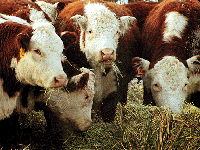
Purebred animals are usually fairly valuable, they are sold to other breeders, or to commercial producers who value the special traits of the purebred animal, but they are not used primarily for meat production. A hereford is shown in the image at the left. |
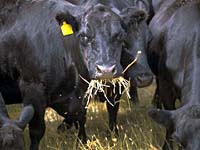
Two of the most common types of beef cattle are the Hereford (shown above) and the Angus (shown at left). Both of these breeds plus the Shorthorn, were the early breeds introduced to Canada. Beef cattle differ physically from dairy cattle; they have a broader, heavier set body with a shorter neck and legs than dairy cattle. Their main purpose is of converter; that is, they convert feed efficiently into high quality meat for human consumption. Herefords are the most recognizable breed to the average person; white-faced with distinctive colour markings and a red body. The breed withstands the extremes in prairie weather -- hot, dry summers, and cold winters. They are muscular, have solid bone structure, are excellent grazing cattle, and are able to walk great distances to water if necessary.
Aberdeen-Angus cattle originated in the counties of Aberdeen and Angus in Scotland. They are bred for production of superior carcasses and higher quality meat. They are excellent mothers, ease in calving, are resistant to certain diseases and the meat produced has excellent marbelling.
Shorthorns came to Canada in 1825; they were imported form England by the New Brunswick agriculture department. The cows have better milking ability than most other beef breeds. Bulls can reach up to 2000 pounds and the shorthorn is more rectangular in shape than other breeds. Breeders will use either male or female shorthorns and breed them to any other breed. The offspring have the ability to produce top quality carcasses.
|
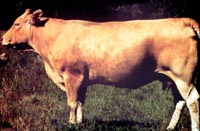
Other common breeds of beef cattle include Blondes, Charolais, Limousin, Longhorn, Maine-Anjou, Salers, Galloways, Santa Gertrudis and Simmentals.
Blondes originated in France and came to Canada in the early seventies. Since then, they have steadily increased in numbers and proven to be high performance animals under feedlot conditions with excellent daily weight gains. The Commercial Cattlemen -- ranchers raising cattle for the marketplace -- use Blonde Bulls in their crossbreeding program to produce healthy , vigorous calves with good feed conversion and carcass quality. Blondes have good mothering ability, a good temperament and are easy calving. They have proven adaptable to a wide range of climates and tolerate Canadian winters very well. This type of beef cattle have a high meat to bone ratio, which is a desirable economic feature.
|
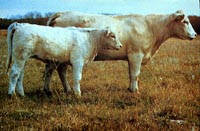
Charolais is one of the oldest breeds of French cattle. The Charolais breed has grown in numbers since 1954, when the first Charolais bull was imported from the U.S. to Canada. It has become the second largest purebred beef breed in Canada. Charolais are usually white or cream in colour and are noted for their ability to grow quickly and adapt to various climatic conditions.
|
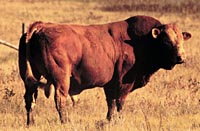
Larger in size than Hereford and Angus, the Limousin is smaller than Charolais and Simmental cattle. Limousin cattle are solid red in color with lighter shades of red around their eyes and mouth. The first Limousin came to Canada from France in 1968 and have become very popular in Canada. They are known for their leanness and muscling ability.
|
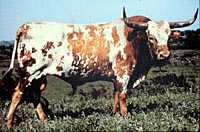
Ancestors of the Longhorn cattle originated in Spain in the 15th century. Longhorn cattle have high fertility and longevity, are excellent milkers, ease in calving, disease resistant and are hardy. The calves vary in color and are vigorous, fast growing and healthy. The average weight of the mature bull is around 1800 pounds (over 800kg). Calves weigh around 55 pounds (22kg) when born. Commercial cattlemen use Texas Longhorn bulls on heifers for their calving ease. Longhorn cows have been known to calve annually to the age of 33 years.
|
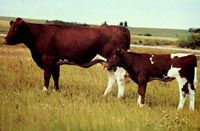
Maine-Anjou are often dark red and white in colour. Maines, as they are sometimes referred to, are excellent feed converters and are known for their maternal traits and quiet nature. Maine-Anjou beef cattle originated in west-central France.
|
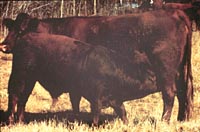
Salers were introduced into Canada in 1972. This breed is noted for the maternal characteristics of the cows (ease of calving and milk production). They have a thick red coat which provides good protection against the harsh prairie winters.
|

Galloways were originally developed in Scotland and brought ot Ontario in the mid-1800s. About 50% of all purebred galloways are in Saskatchewan. They are hardy, have good foraging ability, and they are good mothers. The calves are healthy and tough when born. The females are known for their longevity. Bulls are burly and easy to handle.
|

The Santa Gertrudis is a cross between the Shorthorn and Brahma breeds and they are typically dark red in colour and is suited to warmer climates. This breed was developed in Texas and have proven to be good gainers and they are larger than the Brahma.
|
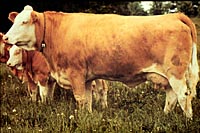
The Simmental is an older breed of beef cattle. They are renowned for their docile manner and they have the ability to provide both milk and meat production at a high level. They are a fairly new breed to Canada, being introduced in the 1980's.
|
